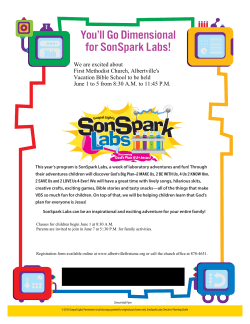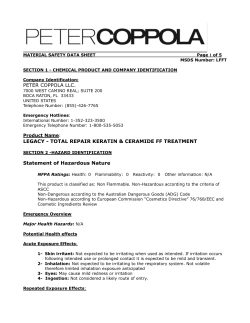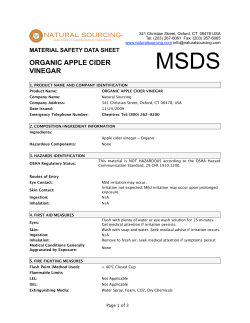
Material Safety Data Sheet Vegetable Glycerin USP
Version 1.14 Revision Date 3/5/2014 Material Safety Data Sheet Vegetable Glycerin USP Section 1: Chemical Product and Company Identification Product Name: Vegetable Glycerin USP Catalog Codes: VG-60ML, VG-120ML, VG-250ML, VG-500ML, VG-1GAL Synonyms: 1,2,3-Propanetriol; Glycerol; Glycerin; Glycerine CAS#: 56-81-5 Chemical Formula: C3H8O3 Contact Information: Wizard Labs 6808 Hanging Moss Rd. Orlando, Florida 32807 (321) 422-0803 wizardlabs.us CHEMTREC (24HR Emergency Telephone) 1-800-424-9300 Section 2: Hazards Identification Emergency Overview: This product is not considered hazardous as defined by the OSHA Hazard Communication Standard, 29 CFR 1910.1200. May cause temporary irritation with eye or skin contact. May cause temporary irritation of upper respiratory tract if inhaled. Repeated or prolonged exposure at high dosage may be harmful to kidneys. Potential Chronic Health Effects: Carcinogenic Effects: Not available Mutagenic Effects: Not available Teratogenic Effects: Not available Section 3: Composition / Ingredient Information Principal Component: Glycerin (56-81-5) 100% Section 4: First Aid Measures Eyes: Immediately flush the eyes with water or eye wash solution for 10 minutes, lifting lower and upper eyelids occasionally. Seek medical attention if irritation persists. Skin: Remove contaminated clothing and flush the affected area immediately with plenty of water. Seek medical attention if irritation occurs. Ingestion: Rinse mouth with water. Seek medical attention if symptoms occur. Never give anything by mouth to an unconscious person. Do not induce vomiting unless directed to do so by medical personnel. Inhalation: Remove victim to fresh air. If not breathing, give artificial respiration. Seek medical attention if symptoms occur. Section 5: Firefighting Measures Flash Point: Closed Cup: 320°F Extinguisher Media: Use media suitable to extinguish surrounding fire. Protective Equipment: Firefighters should wear full protective equipment and NIOSH approved self-contained breathing apparatus. NPFA Rating: Health: 1 Fire: 1 Reactivity: 0 Section 6: Accidental Release Measures Personal Precautions: Use personal protection recommended in Section 8. Environmental Precautions: Isolate the hazard area and evacuate unprotected personnel to safe area. Ventilate area and contain spill with sand or absorbent material. Prevent large spills from entering drains. Avoid discharge of spilled material into the environment or waterways. Place all contaminated material in a sealed bag or container for disposal. Wash spill area after pickup is complete. See Section 13 for disposal information. Section 7: Handling and Storage Handling: Avoid contact with skin and eyes. Use with adequate ventilation and avoid breathing vapor or mist. Storage: Keep container tightly closed in a cool, dry, well-ventilated place. Store away from incompatible materials such as oxidizing agents. Containers that are opened must be resealed and stored upright to prevent leakage. Hydroscopic. Section 8: Exposure Controls / Personal Protection Eye Protection: Chemical splash goggles should be worn. Eyewash bottle or station should be readily available. Respiratory Protection: None needed under normal conditions of use with adequate ventilation. Use NIOSH/MSHA chemical cartridge respirator if PEL or TVL is exceeded. Skin Protection: Chemical resistant clothing and gloves should be worn. Wash hands thoroughly after handling material and before eating or drinking. Section 9: Physical and Chemical Properties Appearance: Clear colorless viscous liquid Odor: Faint Taste: Sweet Molar mass: 92.09 g/mol Density: 1.261 g/cm3 at 20°C pH: ~7 Solubility: Miscible in water Boiling Point: 554°F Melting Point: 64°F Flash Point: Closed Cup: 320°F Section 10: Stability and Reactivity Chemical stability: Stable Reactivity: Highly reactive with oxidizing agents. Incompatible with strong oxidizers (e.g., chromium trioxide, potassium chlorate, potassium permanganate). Hygroscopic. Section 11: Toxicology Information Toxicity Data: Acute oral toxicity (LD50): 12600 mg/kg (Rat) Acute dermal toxicity (LD50): 10000 mg/kg (Rabbit) Acute inhalation toxicity (LC50): NA Chronic Effects: NA Section 12: Ecological Information Ecotoxicity: Ecotoxicity in water (LC50): 58.5 ppm 96 hours [Trout]. EPA Waste Numbers: NA Section 13: Disposal Considerations Waste Disposal: Dispose in accordance with federal, state and local environmental control regulations. Section 14: Transportation Information DOT Classification: Not regulated for transport Section 15: Regulatory Information EPA TSCA Status: On TSCA inventory California Prop 65: This product contains no listed substances known to the State of California to cause cancer, birth defects or other reproductive harm, at levels which would require a warning under the statute. Section 16: Other Information The information provided in this Material Safety Data Sheet represents a compilation of data drawn directly from various sources available to us. Wizard Labs makes no representation or guarantee as to the suitability of this information to a particular application of the substance covered in the Material Safety Data Sheet. Any employer must carefully assess the applicability of any information contained herein in regards to the particular use to which the employer puts the material. Wizard Labs makes no warranty, expressed or implied, including (without limitation) warranties with respect to the completeness or continuing accuracy of the information contained herein or with respect to fitness for any particular use. Copyright © 2013 Wizard Labs. All rights reserved.
© Copyright 2025





















